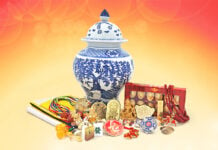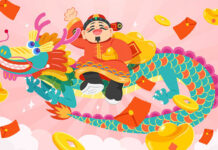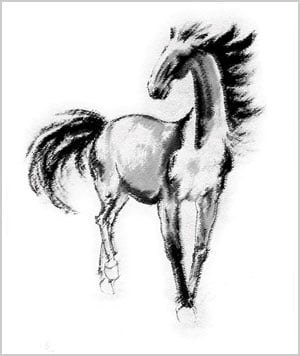 Of the twelve animals of the Chinese Zodiac, the horse stands out for the many attributes it symbolizes. For centuries, the horse has been indispensable to man, as man’s partner in war, and in peace the horse has been used in transportation for centuries.
Of the twelve animals of the Chinese Zodiac, the horse stands out for the many attributes it symbolizes. For centuries, the horse has been indispensable to man, as man’s partner in war, and in peace the horse has been used in transportation for centuries.
A Roman emperor even deified his favourite steed, ordering his subjects to worship it as a God! Today the horse is best known in the world of sports. In racing and in competitive riding, it has captured the modern world’s imagination as powerfully as it did during ancient times.
In feng shui, the horse is associated with speed, strength, perseverance and nobility. The Tribute Horse signifies wealth coming into the family, while the Victory Horse brings success and triumph.
Long tamed, domesticated and bred by Man, the horse signifies courage and speed. Car engines are measured in ‘horsepower’! In the home, a horse figurine placed in the South corner activates recognition, fame and promotion for members of the household bringing renown and respect, especially to the women of the household.
Horse statuettes in the Southwest promote social acceptance and elevation, while in the Northeast the horse brings prominence to scholars and students. Those wanting scholarships would benefit from having a horse in the Northwest direction. The horse is also linked to a comfortable life and a speedy ascent to power, useful attributes for businessmen and those holding high-ranking positions.
Fire is the Horse’s natural element and this magnificent creature is a great generator of yang energy. Paintings and figurines of horses, either solitary or in groups of nine are common in offices and homes of wealthy Chinese tycoons.
The Tribute Horse
The most auspicious and powerful is the Tribute Horse. Traditionally white, the Tribute Horse is laden with gifts of gold, jade, coins or nuggets. The custom started in the Sung dynasty, when victorious generals returning after battle presented spoils of war to the emperor, who in turn would reward them with land, titles and gifts of silk and jade. Since then, high-ranking courtiers and mandarins decorated their homes with such figurines, as it is an excellent image to invite in acceptance into the corridors of power, success and high rank. Receiving or giving a Tribute Horse generates opportunities for mutual benefits.
Horses are particularly useful for those working in highly competitive fields and those surrounded by rivals. If you need an edge over the neighing masses, investing in a Tribute Horse is said to work wonders.
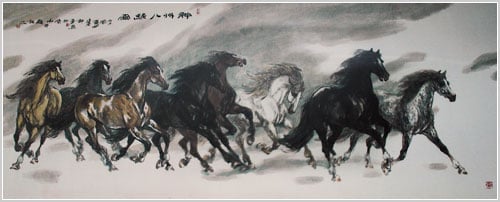
Tang Horses
During the Tang (618-907) and Sung dynasties, horses were part of the artifacts in burial chambers of royalty and the elite. Together with ceramic models of musicians, dancers, servants and camels, horses were deemed as necessities and luxuries of life in both worlds. Horses were never considered beasts of burden but partners in military campaigns and work.
This was the heyday of the fabled Silk Road when the Chinese first gained contact with the Middle East and Europe. Horses, camels and donkeys were the sole means of transport. The three-coloured (green, brown, red) ‘sancai’ horses were held in high esteem when first manufactured and continue to attract collectors today. Horses were viewed as status symbols, as only royalty, military and the rich were allowed to ride them.
Ceramic horses used as burial objects were called ‘mingqi’ and include courtiers, the so-called ‘fat ladies’, musicians, grooms and guardian deities. Most people cannot afford such antiques, but modern reproductions faithfully replicate the sumptuous details and are considered fantastic bringers of good luck.
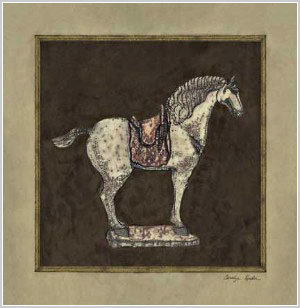 Horses in European culture
Horses in European culture
Like the Chinese, the Europeans revered their horses but took their adoration to the extreme unlike the practical minded Chinese! The horse symbolizes knighthood and chivalry, as these words were derived from French and Latin words for ‘horse’. The most well known in mythology is Pegasus the winged steed, still one of the most popular and beautiful symbols in modern culture.
Horse as God
The mad Roman emperor Caligula elevated his favorite steed ‘Incitatus’ into a Consul, one of the chief judges of Rome. Magistrates had to interpret whether its nodding and neighing signified either ‘yes’ or ‘no’! When it died, Caligula declared Incitatus as a deity, to be worshiped as a god.
It was the horse that won Central America for the Spanish conquistadors as the Mayans had never seen such creatures before and decided they must be divine beasts serving a superior race.
Famous Horses Throughout History
As expected, the most famous horses are associated with great religious figures and military commanders. The best-known example before Christ is Bucephalus (‘Oxhead’), which belonged to Alexander the Great. It would only allow Alexander and no one else to sit on its back and would kneel before the king to allow him to mount. He served Alexander for 30 long years, carrying him into countless victorious battles. When Bucephalus died, Alexander the Great built an entire city called Bucephalia as a mausoleum.
The Duke of Wellington’s stallion was Copenhagen, which he rode into the famous Battle of Waterloo for 30 hours nonstop! Napoleon had his charger Marengo, named after the battle of that name in 1800, which carried him with sure footedness and swiftness. Marengo was his white favourite Barbary horse brought over from Egypt.
In more recent times, Field Marshal Earl Roberts who won fame in India and in the Boer War, was never without his horse named Colonel. In World War 1, General Jack Seely was inseparable from Warrior about whom he later wrote a book. Ronald was the chestnut that carried Lord Cardigan through the Charge of the Light Brigade at Balaclava in 1854. It was possibly the most ill advised charge in history, prompting the acclaimed poem ‘The Charge of the Light Brigade’ by Alfred, Lord Tennyson with the immortal lines “theirs is not to reason why, theirs is but to do and die”.
Kantaka is the famous white horse of Prince Siddartha Gautama who later became the Buddha. It was Kantaka, which carried the young prince out of the fortified palace into the wilderness as he embarked on his search for enlightenment. Upon reaching the city’s limits, Siddartha took leave of Kantaka to walk, as he wanted to lead the life of a beggar. Tied to a tree so he could not follow his beloved master, Kantaka watched till Siddartha vanished from view. Realizing he would never see him again, he died of a broken heart and was received by angels into heaven to wait for the reunion.
Fadda is the white horse of Prophet Muhammad, founder of Islam and in the Koran, Haizum is the steed of the archangel Gabriel.




